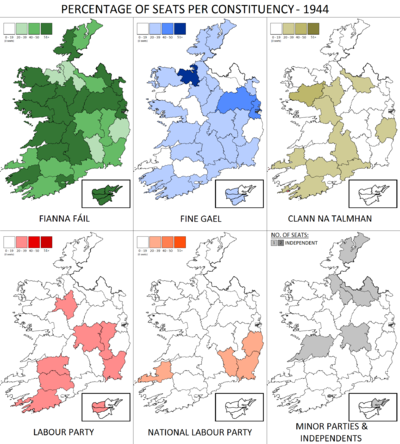Irish general election, 1944
|
|
|||||||||||||||||||||||||||||||||||||||||||||||||||||||||||||||||||||||||||||||||||||||||
|---|---|---|---|---|---|---|---|---|---|---|---|---|---|---|---|---|---|---|---|---|---|---|---|---|---|---|---|---|---|---|---|---|---|---|---|---|---|---|---|---|---|---|---|---|---|---|---|---|---|---|---|---|---|---|---|---|---|---|---|---|---|---|---|---|---|---|---|---|---|---|---|---|---|---|---|---|---|---|---|---|---|---|---|---|---|---|---|---|---|
|
|||||||||||||||||||||||||||||||||||||||||||||||||||||||||||||||||||||||||||||||||||||||||
|
|
|||||||||||||||||||||||||||||||||||||||||||||||||||||||||||||||||||||||||||||||||||||||||
|
137 of 138 seats in Dáil Éireann 70 seats were needed for a majority |
|||||||||||||||||||||||||||||||||||||||||||||||||||||||||||||||||||||||||||||||||||||||||
| Turnout | 69.2% | ||||||||||||||||||||||||||||||||||||||||||||||||||||||||||||||||||||||||||||||||||||||||
|
|||||||||||||||||||||||||||||||||||||||||||||||||||||||||||||||||||||||||||||||||||||||||

Percentage of seats gained by each of the five biggest parties, and number of seats gained by smaller parties and independents.
|
|||||||||||||||||||||||||||||||||||||||||||||||||||||||||||||||||||||||||||||||||||||||||
|
|||||||||||||||||||||||||||||||||||||||||||||||||||||||||||||||||||||||||||||||||||||||||
The Irish general election of 1944 was held on 30 May 1944, three weeks after the dissolution of the Dáil on 9 May. The 138 newly elected members of the 12th Dáil assembled on 9 June when the new Taoiseach and government were appointed. The outgoing Fianna Fáil government won re-election, and achieved an overall majority.
The general election took place in 34 parliamentary constituencies throughout Ireland for 138 seats in the lower house of parliament, Dáil Éireann. The election was fought while the Emergency Powers Act 1939 was still in force.
The general election of 1944 was caused by a defeat for the ruling Fianna Fáil government on the second reading of the Transport Bill. The Taoiseach Éamon de Valera, decided to call a snap general election, just one year after the last. It was a campaign that Fianna Fáil needed to have a more comfortable position in the Dáil, however, the campaign was not wanted by the opposition parties.
Fianna Fáil fought the election on its record in government and also in the hope of securing a fresh mandate for its policies. During the campaign Fine Gael put forward the proposal of forming a coalition government with the Labour Party and Clann na Talmhan, however, this was ridiculed by Fianna Fáil as untenable. A split in the Labour movement meant that the party was by no means ready to fight an election, and the results showed this.
...
Wikipedia



